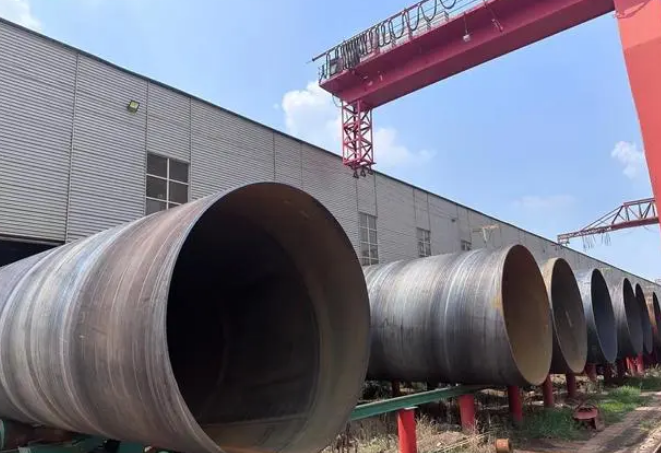Spiral steel pipes are also called spiral welded pipes. Low carbon structural steel or alloy steel is rolled into a tube shape according to a regular spiral angle and then welded together. It can also be produced with narrow steel pipes. It is mainly used in oil, natural gas, bridges, The specifications of pipeline transportation pipelines in docks, roads, buildings and other engineering projects are expressed by outer diameter * wall thickness. Spiral pipes are either single-sided or double-sided. Welded pipes should ensure that the hydraulic pressure test, tensile strength and cold bending performance of the weld meet national regulations. Let's take a look at the relevant knowledge of spiral steel pipes with carbon steel pipe manufacturers.

The main technical points of spiral steel pipe:
1. During the forming process, the steel plate deforms uniformly, with small residual stress and no scratches on the surface. The processed spiral steel pipe has greater flexibility in the diameter and wall thickness range, especially when producing high-grade thick-walled pipes, especially small and medium-diameter thick-walled pipes. It has advantages that other processes cannot match and can meet the needs of User needs. There are more requirements for spiral steel pipe specifications.
2. Advanced double-sided submerged arc welding technology can achieve optimal position welding, which is less prone to problems such as edge errors, welding deviations, and welding defects, and facilitates the control of welding quality.
3. In order to effectively detect and monitor the entire steel pipe production process, 100% quality inspection of steel pipes is carried out to effectively ensure product quality.
4. All equipment in the entire production line has the function of networking with the computer data collection system to realize real-time transmission of data. The technical parameters in the production process are controlled by the central control room.
5. The raw materials are coiled pipe, wire and flux. Strict physical and chemical inspections are required before entry.
6. Peel off the steel head and tail butt joints, use single wire or double wire submerged arc welding, roll it into a steel pipe, and automatically perform submerged arc welding repair welding.
7. Before forming, the strip is leveled, trimmed, planed, surface cleaned, transported and pre-bent.
8. Use electrical contact pressure gauges to control the pressure on both sides of the conveyor to ensure smooth transportation of the steel belt.
9. Use external control or internal control of roll shape.
10. Use welding control devices to ensure that the welds meet the welding requirements and strictly control the pipe diameter, dislocation and welds.
11. In order to obtain stable welding quality, the American Lincoln welding machine uses single-wire or double-wire submerged arc welding for internal and external welding.
Things to note when welding spiral steel pipes:
Welding and cutting of spiral steel pipe structures are inevitable in spiral steel pipe applications. Due to the characteristics of the spiral steel pipe itself, the welding and cutting of the spiral steel pipe has its own particularities compared with ordinary carbon steel. It is more likely to produce various defects in its welded joints and heat affected zone (HAZ). The welding performance of the spiral steel pipe is mainly reflected in In the following aspects, high-temperature cracks. The high-temperature cracks mentioned here refer to cracks related to welding. High-temperature cracks can be roughly divided into solidification cracks, microcracks, HAZ (heat-affected zone) cracks, and reheating cracks.
Low temperature cracks Low temperature cracks sometimes occur in spiral steel pipes. Because the main causes are hydrogen diffusion, the degree of constraint of the welded joint, and the hardened structure therein, the solution is mainly to reduce the diffusion of hydrogen during the welding process, appropriately perform preheating and post-weld heat treatment, and reduce the degree of constraint.
The toughness of welded joints in spiral steel pipes is usually designed to contain 5% to 10% ferrite in order to reduce the susceptibility to high-temperature cracks. However, the presence of these ferrites leads to a decrease in low temperature toughness.
When spiral steel pipes are welded, the amount of austenite in the welded joint area is reduced, which affects the toughness. In addition, as the ferrite increases, its toughness value has a significant downward trend. It has been proven that the toughness of welded joints of high-purity ferritic stainless steel decreases significantly because of the mixing of carbon, nitrogen, and oxygen.
The increase in oxygen content in the welded joints of some steels generates oxide-type inclusions. These inclusions become the source of cracks or the path for crack propagation, causing the toughness to decrease. Some steels are mixed with air in the protective gas, and the nitrogen content increases to produce lath-like Cr2N on the cleavage plane {100} of the matrix. The matrix becomes hard and the toughness decreases.
σ phase embrittlement: Austenitic stainless steel, ferritic stainless steel and duplex steel are prone to σ phase embrittlement. Because a few percent of the α phase is precipitated in the structure, the toughness is significantly reduced. The "phase" generally precipitates in the range of 600 to 900°C, especially around 75°C. As a preventive measure to prevent the occurrence of the "" phase, the ferrite content in austenitic stainless steel should be reduced as much as possible.
Embrittlement at 475°C, and when kept at 475°C (370-540°C) for a long time, the Fe-Cr alloy decomposes into an α solid solution with a low chromium concentration and an α’ solid solution with a high chromium concentration. When the chromium concentration in the α’ solid solution is greater than 75%, the deformation changes from slip deformation to twin deformation, resulting in 475°C embrittlement.


